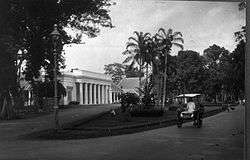Volksraad (Dutch East Indies)
A People's Council (Volksraad) for the Dutch East Indies was provided for by law in 1916, but its establishment was procrastinated until the actual installation of the Council in 1918. It was a hesitant and slow attempt at democratisation of the Dutch East Indies. The power of the Volksraad was limited as it only had advisory powers. Although part of the council was elected only a small proportion of the population had voting rights.[1]

The Volksraad had sixty members: 30 members from various indigenous groups, 25 European, and 5 from Chinese, Arab and other Foreign Orientals. The Volksraad was reconstituted every four years. The members of the Council were partly chosen, partly appointed by the colonial administration.[1]
History
_Kan_Hok_Hoei_(benoemd)_R._Sastro_Widjono_(gekozen)_en_mas_ngab%C3%A8hi_Dwidjo_Sewojo_(benoemd)_TMnr_10001376.jpg)
The Volksraad was founded in Weltevreden, Batavia, Java, as an infant form of democratic representation on 18 May 1918 by the "ethical" colonial chief executive Count van Limburg Stirum (1873–1948), who was Governor-General of the Dutch East Indies from 1916 to 1921.
In 1925 the Volksraad was made a semilegislative body; although decisions were still made by the Dutch government, the governor-general was expected to consult the Volksraad on major issues.
The last election was in 1939. In 1942 the Volksraad was dissolved during the Japanese occupation.[2]
In 1945 the Volksraad building located in Weltevreden was renamed the Pancasila building.
Members
The term of office for Volksraad members was three years, in 1925 increased to four years. Famous Indo-European members included Karel Zaalberg and Dick de Hoog.
There were also representatives of the colony's Vreemde Oosterlingen, or 'Foreign Orientals', including Chinese members, such as Khouw Kim An, Majoor der Chinezen, H. H. Kan and Loa Sek Hie, as well as Arab members, like Sayyid Ismail bin Sayyid Abdoellah bin Alwi Alatas..
Among prominent indigenous parliamentarians in the Volksraad were the Javanese Tjokroaminoto and Mohammad Husni Thamrin, the Sumatran Agus Salim and the Menadonese Sam Ratulangi.
Gallery
-

Volksraad building. Weltevreden, Batavia.
-

Dick de Hoog, president of the I.E.V. and member of the Volksraad.
References
Notes and citations
- 1 2 Harry J. Benda, S.L. van der Wal, "De Volksraad en de staatkundige ontwikkeling van Nederlandsch-Indië: The Peoples Council and the political development of the Netherlands-Indies." (With an introduction and survey of the documents in English). (Publisher: J.B. Wolters, Leiden, 1965.)
- ↑ Volksraad article Britannica.
Bibliography
- Palmer and Colton. A History of the Modern World (McGraw-Hill, Inc. 1992). ISBN 0-07-557417-9
- Ricklefs, M. C. A History of Modern Indonesia Since c. 1300 (Stanford University Press, 2001).